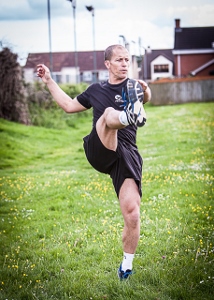Do Warm Ups Affect Performance?
The goal of the warm up is to prepare the body mentally and physically for exercise or competition.
 We would therefore look for the following positive effects:
We would therefore look for the following positive effects:
- Faster muscle contraction and relaxation.
- Improved rate of force development and reaction time.
- Improvements in muscle strength and power.
- Skill preparation and mental focus.
Methods that are used include;
- Low intensity aerobic exercise followed by static or dynamic stretching.
- Sport specific drills.
- Lighter weights set before heavy weights session.
Many studies have been carried out to ascertain the best way to warm up an athlete for a session. Due to the varying testing methods and protocols, a large majority of these have little relevance for a sports environment.
What does research tell us about warm ups?
A Meta-Analysis for the Journal of Strength Conditioning Research looked initially at over 2000 studies but found only 32 met the criteria of being relevant to sporting activity on humans, and included 2 or more components of a warm up, in English (24 (1) 140 -148, 2010)
Of these 32 studies, 79% of these found that the warm up method improved the subjects performance in a given activity. When evaluating the studies that showed a decline in performance, it was found that the warm up method was not suited to the activity.
The suitability of a warm up is paramount to improved performance as shown in the above analysis. One rule that can be used is SAID (Specific Adaptations to Imposed Demands). This means we tailor the warm up to the athletes level of fitness and to the main session plan.
- Why warm up with a low intensity aerobic exercise for a weights session, wouldn’t a warm up involving similar movement patterns be more beneficial?
- Why warm up with linear movements for a hockey game, wouldn’t multi lateral movements be more suitable?
Using SAID we could question different stretching methods; would static stretching be suitable for a warm up? Some would argue yes as it elongates a muscle to natural length and therefore it should contract better.
Others however would disagree saying the muscle is too relaxed after the stretch. These arguments are based on anecdotal and research evidence due to the different studies and methods.
Summary of the best way to warm up
Without further studies on times between stretching and the activity amongst things, its difficult to come to a conclusion on whether static stretching is detrimental, however most studies have shown that a more dynamic warm up is suitable to the activity and improves performance.
The RAMP method (Raise, Activate, Mobilise and Potentiate) along with the SAID rule provides a structure from which a warm up can be designed to provide an effective pre exercise routine.
On our Foundation in Athletic Development Coaching Course we help sports coaches and p.e. teachers design better warm ups.

[…] warm ups and circuits was new to a lot of the group: and it highlighted some interesting points. If you […]
[…] sitting for prolonged periods at work or commuting, so this needs to be managed with effective warm ups prior to games and training […]
[…] Do warm ups affect performance? […]